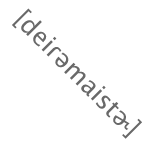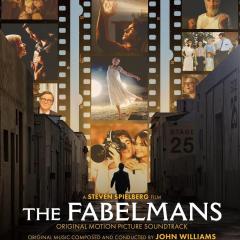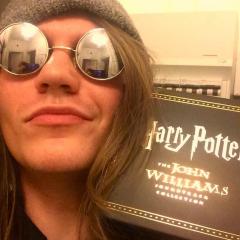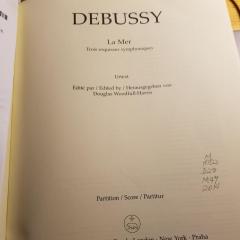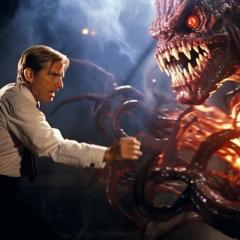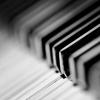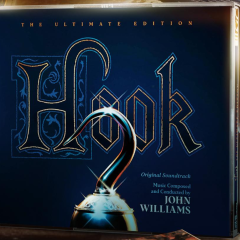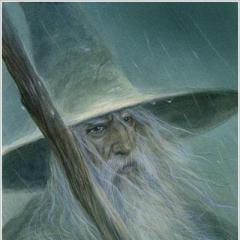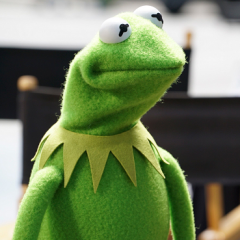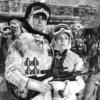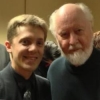-
Posts
12,520 -
Joined
-
Last visited
-
Days Won
9
Reputation Activity
-
 Datameister got a reaction from KK in Questions about Music Theory Thread
Datameister got a reaction from KK in Questions about Music Theory Thread
I know this answer is coming a few weeks late, but if you're still interested, Audacity is a free download and it can do this quite easily. Just add as many tracks as you need (one for each pitch) and then for each track, go Generate > Tone... and choose what you want. Certainly not a great way to create whole compositions, but if you just want to hear what different nonstandard intervals and chords sound like, it an effective tool.
-
 Datameister got a reaction from Will in Unique "Williams-isms"?
Datameister got a reaction from Will in Unique "Williams-isms"?
This is something I (and countless others, I'm sure) have thought about from time to time. It's more of an accumulation of small things, I'm sure. Putting one's finger on exactly what those are requires varying degrees of knowledge about music theory. I can offer some rather low-level observations about a variety of (mostly orchestration-related) techniques Williams is fond of:
* For certain types of big, brassy fanfares, he'll often use block chords in the trumpets, with the trombones playing the same thing an octave below, sometimes with some chords in slightly different inversions. The horns are sometimes used to fill in the gaps, reinforce the middle voices, and/or double the trumpets.
* In dissonant passages, Williams likes to use an unusual chord that I'm not sure what to call. An example would be (in ascending order) C-Ab-B. Williams will stack this sort of chord against other chords in all kinds of ways to create various sorts of tension.
* Action music very often calls for ascending runs in the woodwinds, sometimes doubled by the strings, piano, and/or percussion. Typically, these are not chromatic - they instead follow a scale that's appropriate to the harmonic structure of the music at that moment. The flutes, oboes, and clarinets will all play the entire run in two, three, or even four octaves, with the individual instruments dropping out or dropping an octave when they start to get too high. (These choices are typically made by his orchestrators - in WIlliams' sketch, he just writes out the run in a single octave and writes "wind" above it. His orchestrators understand that he wants it broken up among all these instruments according to their respective ranges.)
* Lush or sweeping melodies are often given to all the strings except the basses. The violins, violas, and cellos all play the melody in octaves, although the top octave or two in the violins are primarily what you hear. Meanwhile, the basses will be playing a pizzicato bassline that emphasizes the downbeats. Trombones or horns will be given simple chords in the middle of their range, with the woodwinds perhaps doubling the strings or interjecting little contrapuntal lines.
* Williams seems to be a fan of open spacing in the strings. For passages heavily featuring the strings, many of the chords will only hit every other note, creating a less densely packed sound. There are also certain types of chords and chord progressions he tends to prefer in these passages, but I have a hard time articulating generalizations about those. He also tends to flow freely from divisi to unisono in each part, depending on what that part of the passage calls for. (This is also handled by the orchestrator at times, but he's very specific in his sketches at other times.)
* Aleatoric effects are very useful for stuff that's supposed to sound tense or frightening. This happens most often with the strings...he'll give a series of low pitches to the cellos and basses and tell them to play quickly ad lib, for instance. Or have the violins and violas play random pizzicato notes, or glisses at varying speeds. Sometimes the piano and/or harp will get involved, adding a little more definition to the randomness. The woodwinds also get these sorts of notations sometimes (notably in TLW), although those effects tend to be less noticeable. With the exception of the x-shaped noteheads in the piccolos marked "highest pitch" or "shriek!", that is. Those can be quite piercing.
* Quick-ish runs and figures with violin and viola tremolos are often used to add a frantic edge to action music, often just as background to other stuff. These are typically really tough to analyze because they don't follow any immediately obvious harmonic structure. (Yet they somehow sound so good...)
* Muted trombones make for a snarly, sinister sound that Williams loves to use in darker passages. Sharp, biting, isolated notes are effective, as are slow glisses and dramatic crescendos and whatnot. Williams also uses mutes fairly often in the trumpets, most commonly to add a bright edge to sinister tone clusters. Horns get muted or stopped with surprising frequency...he calls for metal mutes, fiber mutes, all kinds of stuff. These are also often used to create a more sinister sound, or at least more veiled and introspective.
* Six horns in unison make for a very strong sound that Williams loves...as do I. Great for full-on melodies or fanfare-like counterpoint. He's also a fan of giving heroic melody lines to three or four trumpets in unison, although with these, he's more likely to allow the lower trumpets to deviate from the melody for parts of the passage.
* On a related topic, horns in their lowest register can create an ominous, unusual substitute for the low brass. They're not too agile or pretty-sounding when you take them that low, but three to six horns delivering a few simple, deep pedal tones can really produce an awesome sound.
* It's rather rare for Williams to stay in one key for long, unless he's in the midst of a long melody line or a fairly monotonous passage. He's constantly modulating from key to key, and not through especially trite chord progressions, either. I find that this lends a certain sense of motion and change to his music that I much prefer to the rather static key signatures often found in pop music - and classical music, for that matter. Other film composers do this, too, but there's something idiosyncratically wonderful about Williams' continual, effortless, unobtrusive shifting from key to key. (And these keys may be only subtly implied, or so fleeting that their durations can be measured in beats, not measures...let alone dozens of measures, or whole cues.)
* Synths are very often used to double the strings, add special sound effects (wind, animal vocalizations, hissing, explosions, etc.), mimic percussion, mimic celeste, double the piano, or create timbres that are similar to dulcimers or other less common instruments. These effects range from very prominent to so subtle it's almost impossible to make them out when you already know what they're playing, but they're very common.
* Aside from soloistic capacities, Williams mainly uses piano to double the basses and cellos, to create deeply resonant effects with very low clusters, to create percussive clangs with very high clusters, to double runs and punctuated octaves in the woodwinds, or to play fluid and unobtrusive arpeggios that serve as background for more important material. Oh, and he also likes to do quick, dissonant, ascending arpeggios, often doubling harp and/or some sort of synth sound, for moments of surprise or shifts in mood.
* Synth celeste plus woodwinds and sometimes trumpet can make for a nice, not-too-serious sound, particularly with short, staccato phrases.
* Harp glissandos are used shamelessly all over the place, especially in louder music. Great for accentuating a crescendo, or for adding texture to a longer passage ad lib.
* Parallel thirds show up in a lot of different contexts. Parallel minor chords, too, for that matter, with certain chords going into different inversions as needed.
* Sort of similar...Williams has written a number of passages that give the horns and strings a series of major chords (that don't really fit together into any single scale), such that the top note creates a melody in a minor key. There's usually a pedal tone beneath. Examples include the motif that's used in several scenes on Utapau in ROTS, the music that plays as the rebels are getting ready to leave their station in ROTJ, and the theme from TLW.
* There's no denying that Williams' preferred recording techniques and performance styles have influenced his sound. When a different orchestra plays his music in a different hall, the results can be remarkably different. Still recognizable as Williams, sure, but there are a lot of subtle but recognizable things about the way Williams' scores are generally played and recorded and mixed and whatnot. These have, of course, changed over the years with different technologies and venues and trends and whatnot.
* Let's talk percussion. Snare drums or field drums ("drums" or "deep drums"), cymbals ("piatti"), and bass drum ("gran cassa") are crucial for passages that are militaristic. Sometimes even a few ruffs and simple figures on a snare drum are enough. Vibraphone and marimba often get to softly reinforce harmonic material. Xylophone is most frequently associated with punctuated notes in the woodwinds, sometimes doubled by anvil. Glockenspiel is chiefly used to add brilliance to a melodic line in, say, the trumpets. The timpani are featured all over the place in a wonderfully idiomatic way. Various types of tom toms ("tuned drums" or "deep tuned drums") are great for lending some punch to action music without sounding too militaristic. Various types of "ethnic" percussion (tabla, log drums, etc.) show up for more mysterious effects...triangle adds playful sparkle or dazzling shimmer...tambourine adds an almost dancelike festivity...etc. Typically, the percussion parts are not riddled with rudiments or anything...they don't really sound like they were written by a percussionist, but they're perfectly playable, and they sound extremely idiomatic without sounding like something a drummer just sat down and improvised. They serve the music well.
* Williams' modern action music is typically so harmonically complex that you almost might as well not even bother trying to figure out why it sounds the way it does. In the 70s and 80s, he preferred a slightly more straightforward style of action music that kept things a little harmonically simpler, with a relatively small number of discrete musical ideas going on at any given moment, most of which were pretty bold and accessible. Ostinatos, fanfares, recognizable melodies, comparatively sparse arpeggios and runs and chords. As Williams has continued to gain musical experience and knowledge, he's developed a style of action music that is so "advanced" that it's actually become off-putting to some fans. (That and the over-reliance on certain specific techniques in the music.)
* When the woodwinds get the melody, it's not unusual for Williams to double the oboes and clarinets, or flutes and oboes and clarinets. Gives a rich sound that's less immediately identifiable with any one instrument.
* Last but certainly not least...it's all about the boom-tzzzzz. Once you start paying attention to Williams' good old bass-drum-hit-followed-by-cymbal-crash tool, you'll notice it throughout his action music, as early as the 70s (at least) and as late as KOTCS. I even had one of his sketched boom-tzzzzz's in my sig for a while.
But of course, these are all just pieces of the puzzle. Not a comprehensive list by any means. They're not individually TOO specific to Williams, either. Figuring out why Williams sounds like Williams in broader terms is something that's very difficult to do.
EDIT: I hoped you'd show up, Prometheus. Time to use Google to learn some new music theory terms. EDIT AGAIN: Gasp! You're so right about the octatonic scale. The Hungarian scale seems most common when he's going for a so-called "ethnic" or non-Western feel. Have you noticed it in other contexts, as well?
-

-

-
 Datameister got a reaction from TownerFan in The Book Thief (2013) - New Williams film score!
Datameister got a reaction from TownerFan in The Book Thief (2013) - New Williams film score!
I would, too. Williams' orchestrators are there primarily to perform the technical and fairly time-consuming task of translating his sketches into a format that is more standard and explicit, but the vast majority of the information is already there in the sketches, especially in his later works.
It's interesting to compare Williams' sketches to his orchestrators' manuscripts. In his earlier scores, there are more changes and additions noticeable in the manuscripts, although most of these are quite subtle: doubling a violin line on clarinet, slightly strengthening a bassline, things of that nature. Of course, it's hard to know who came up with these ideas. Based on what little footage we have of Williams and Spencer working together, they would apparently sit down at the piano and go through the next day's sketches together, half-talking and half-playing through them. It's possible that some or all of these changes were suggested by Williams on the fly during this process, just as it's possible that Spencer suggested them to Williams while working on the cues, or any other number of possibilities.
For what it's worth, I don't think playability has tended to be the issue with Williams' works - I don't play a huge variety of instruments myself, but from what I've been able to gather, he's quite good about writing the music in a way that's perfectly idiomatic and playable, so his orchestrators don't have to make many changes on that front.
-
 Datameister got a reaction from Dixon Hill in Datameister's Cue Analysis Thread
Datameister got a reaction from Dixon Hill in Datameister's Cue Analysis Thread
Here's "The Scoring Begins"!
The Scoring Begins Analysis.pdf
The format is different this time, but the type of content is similar. This cue is less harmonically complex, and there's an entire column devoted purely to orchestration, so this one may have broader appeal. I'm curious what y'all think of the different format...I can't decide whether I want to keep it for the next one. For that matter, I can't decide what cue I want to do next, although it's probably going to be a Star Wars OT action cue.
EDIT: I narrowed it down to "The War", "The Asteroid Field", and "The Snow Battle."
"The Asteroid Field" it is.
-
 Datameister got a reaction from Dixon Hill in Datameister's Cue Analysis Thread
Datameister got a reaction from Dixon Hill in Datameister's Cue Analysis Thread
I'm guessing that once they get that good, a lot of it really is instinct. Williams has clearly studied all this stuff, but I would imagine that when you've spent that many thousands of hours positively steeped in music, it just starts to ooze out of your pores without conscious, theoretical analysis.
BTW, I meant to mention that if anyone has requests for specific cues, I'll take those into consideration. Can't make any promises, of course, but you never know! At the moment, "The War" (ANH) is looking like a fairly strong contender, once I've finished "The Scoring Begins." I'd like to do some music from the JP and Indy franchises at some point, too.
-
 Datameister got a reaction from Once in London or Los Angeles for Star Wars VII score? [UPDATE: It's Los Angeles]
Datameister got a reaction from Once in London or Los Angeles for Star Wars VII score? [UPDATE: It's Los Angeles]
On the other hand, an industry insider recently hinted to me that they wanted to use the LSO for the project. Wish I could give more details than that.
-
 Datameister got a reaction from TownerFan in London or Los Angeles for Star Wars VII score? [UPDATE: It's Los Angeles]
Datameister got a reaction from TownerFan in London or Los Angeles for Star Wars VII score? [UPDATE: It's Los Angeles]
On the other hand, an industry insider recently hinted to me that they wanted to use the LSO for the project. Wish I could give more details than that.
-
 Datameister got a reaction from Craig Evans in Randy Kerber - What synth gear has he used in Williams's scores?
Datameister got a reaction from Craig Evans in Randy Kerber - What synth gear has he used in Williams's scores?
Nope, "The Library Scene" is the only cue I can think of that uses real celeste, and that's only for one brief passage. There's a good thread on that here. BTW, I rather agree - I mean, the regular acoustic celeste sound is wonderful, but pairing it with that sine wave decay is genius.
-
 Datameister got a reaction from Craig Evans in Randy Kerber - What synth gear has he used in Williams's scores?
Datameister got a reaction from Craig Evans in Randy Kerber - What synth gear has he used in Williams's scores?
The only specific synthesizer I know he's used is the DX7.
http://www.youtube.com/watch?v=PlkxqepecCw
-
 Datameister got a reaction from indy4 in 2015: The biggest year in the history of blockbuster films?
Datameister got a reaction from indy4 in 2015: The biggest year in the history of blockbuster films?
Personally, all I really need to see in 2015 is Jaws 19.
-
 Datameister got a reaction from Seth in Rate The Star Wars Scores
Datameister got a reaction from Seth in Rate The Star Wars Scores
Star Wars and Empire inevitably tie for me, every time. I give each one the edge in certain categories, but overall, I can't pick one over the other.
After that, things get tricky. Really tricky. I suppose I would most likely put Jedi next, but I think all three prequel scores have some pretty fantastic material in them.
I suppose right now, at this moment, if I absolutely had to rank them all, I'd go:
1. ESB
2. ANH
3. ROTJ
4. TPM
5. AOTC
6. ROTS
But again, really tricky. Ask me another time and I might give you a very different answer, such as:
1. ANH
2. ESB
3. AOTC
4. TPM
5. ROTS
6. ROTJ
Heresy, I know. The heart wants what it wants.
-
 Datameister got a reaction from _deleted_ in Unique "Williams-isms"?
Datameister got a reaction from _deleted_ in Unique "Williams-isms"?
This is something I (and countless others, I'm sure) have thought about from time to time. It's more of an accumulation of small things, I'm sure. Putting one's finger on exactly what those are requires varying degrees of knowledge about music theory. I can offer some rather low-level observations about a variety of (mostly orchestration-related) techniques Williams is fond of:
* For certain types of big, brassy fanfares, he'll often use block chords in the trumpets, with the trombones playing the same thing an octave below, sometimes with some chords in slightly different inversions. The horns are sometimes used to fill in the gaps, reinforce the middle voices, and/or double the trumpets.
* In dissonant passages, Williams likes to use an unusual chord that I'm not sure what to call. An example would be (in ascending order) C-Ab-B. Williams will stack this sort of chord against other chords in all kinds of ways to create various sorts of tension.
* Action music very often calls for ascending runs in the woodwinds, sometimes doubled by the strings, piano, and/or percussion. Typically, these are not chromatic - they instead follow a scale that's appropriate to the harmonic structure of the music at that moment. The flutes, oboes, and clarinets will all play the entire run in two, three, or even four octaves, with the individual instruments dropping out or dropping an octave when they start to get too high. (These choices are typically made by his orchestrators - in WIlliams' sketch, he just writes out the run in a single octave and writes "wind" above it. His orchestrators understand that he wants it broken up among all these instruments according to their respective ranges.)
* Lush or sweeping melodies are often given to all the strings except the basses. The violins, violas, and cellos all play the melody in octaves, although the top octave or two in the violins are primarily what you hear. Meanwhile, the basses will be playing a pizzicato bassline that emphasizes the downbeats. Trombones or horns will be given simple chords in the middle of their range, with the woodwinds perhaps doubling the strings or interjecting little contrapuntal lines.
* Williams seems to be a fan of open spacing in the strings. For passages heavily featuring the strings, many of the chords will only hit every other note, creating a less densely packed sound. There are also certain types of chords and chord progressions he tends to prefer in these passages, but I have a hard time articulating generalizations about those. He also tends to flow freely from divisi to unisono in each part, depending on what that part of the passage calls for. (This is also handled by the orchestrator at times, but he's very specific in his sketches at other times.)
* Aleatoric effects are very useful for stuff that's supposed to sound tense or frightening. This happens most often with the strings...he'll give a series of low pitches to the cellos and basses and tell them to play quickly ad lib, for instance. Or have the violins and violas play random pizzicato notes, or glisses at varying speeds. Sometimes the piano and/or harp will get involved, adding a little more definition to the randomness. The woodwinds also get these sorts of notations sometimes (notably in TLW), although those effects tend to be less noticeable. With the exception of the x-shaped noteheads in the piccolos marked "highest pitch" or "shriek!", that is. Those can be quite piercing.
* Quick-ish runs and figures with violin and viola tremolos are often used to add a frantic edge to action music, often just as background to other stuff. These are typically really tough to analyze because they don't follow any immediately obvious harmonic structure. (Yet they somehow sound so good...)
* Muted trombones make for a snarly, sinister sound that Williams loves to use in darker passages. Sharp, biting, isolated notes are effective, as are slow glisses and dramatic crescendos and whatnot. Williams also uses mutes fairly often in the trumpets, most commonly to add a bright edge to sinister tone clusters. Horns get muted or stopped with surprising frequency...he calls for metal mutes, fiber mutes, all kinds of stuff. These are also often used to create a more sinister sound, or at least more veiled and introspective.
* Six horns in unison make for a very strong sound that Williams loves...as do I. Great for full-on melodies or fanfare-like counterpoint. He's also a fan of giving heroic melody lines to three or four trumpets in unison, although with these, he's more likely to allow the lower trumpets to deviate from the melody for parts of the passage.
* On a related topic, horns in their lowest register can create an ominous, unusual substitute for the low brass. They're not too agile or pretty-sounding when you take them that low, but three to six horns delivering a few simple, deep pedal tones can really produce an awesome sound.
* It's rather rare for Williams to stay in one key for long, unless he's in the midst of a long melody line or a fairly monotonous passage. He's constantly modulating from key to key, and not through especially trite chord progressions, either. I find that this lends a certain sense of motion and change to his music that I much prefer to the rather static key signatures often found in pop music - and classical music, for that matter. Other film composers do this, too, but there's something idiosyncratically wonderful about Williams' continual, effortless, unobtrusive shifting from key to key. (And these keys may be only subtly implied, or so fleeting that their durations can be measured in beats, not measures...let alone dozens of measures, or whole cues.)
* Synths are very often used to double the strings, add special sound effects (wind, animal vocalizations, hissing, explosions, etc.), mimic percussion, mimic celeste, double the piano, or create timbres that are similar to dulcimers or other less common instruments. These effects range from very prominent to so subtle it's almost impossible to make them out when you already know what they're playing, but they're very common.
* Aside from soloistic capacities, Williams mainly uses piano to double the basses and cellos, to create deeply resonant effects with very low clusters, to create percussive clangs with very high clusters, to double runs and punctuated octaves in the woodwinds, or to play fluid and unobtrusive arpeggios that serve as background for more important material. Oh, and he also likes to do quick, dissonant, ascending arpeggios, often doubling harp and/or some sort of synth sound, for moments of surprise or shifts in mood.
* Synth celeste plus woodwinds and sometimes trumpet can make for a nice, not-too-serious sound, particularly with short, staccato phrases.
* Harp glissandos are used shamelessly all over the place, especially in louder music. Great for accentuating a crescendo, or for adding texture to a longer passage ad lib.
* Parallel thirds show up in a lot of different contexts. Parallel minor chords, too, for that matter, with certain chords going into different inversions as needed.
* Sort of similar...Williams has written a number of passages that give the horns and strings a series of major chords (that don't really fit together into any single scale), such that the top note creates a melody in a minor key. There's usually a pedal tone beneath. Examples include the motif that's used in several scenes on Utapau in ROTS, the music that plays as the rebels are getting ready to leave their station in ROTJ, and the theme from TLW.
* There's no denying that Williams' preferred recording techniques and performance styles have influenced his sound. When a different orchestra plays his music in a different hall, the results can be remarkably different. Still recognizable as Williams, sure, but there are a lot of subtle but recognizable things about the way Williams' scores are generally played and recorded and mixed and whatnot. These have, of course, changed over the years with different technologies and venues and trends and whatnot.
* Let's talk percussion. Snare drums or field drums ("drums" or "deep drums"), cymbals ("piatti"), and bass drum ("gran cassa") are crucial for passages that are militaristic. Sometimes even a few ruffs and simple figures on a snare drum are enough. Vibraphone and marimba often get to softly reinforce harmonic material. Xylophone is most frequently associated with punctuated notes in the woodwinds, sometimes doubled by anvil. Glockenspiel is chiefly used to add brilliance to a melodic line in, say, the trumpets. The timpani are featured all over the place in a wonderfully idiomatic way. Various types of tom toms ("tuned drums" or "deep tuned drums") are great for lending some punch to action music without sounding too militaristic. Various types of "ethnic" percussion (tabla, log drums, etc.) show up for more mysterious effects...triangle adds playful sparkle or dazzling shimmer...tambourine adds an almost dancelike festivity...etc. Typically, the percussion parts are not riddled with rudiments or anything...they don't really sound like they were written by a percussionist, but they're perfectly playable, and they sound extremely idiomatic without sounding like something a drummer just sat down and improvised. They serve the music well.
* Williams' modern action music is typically so harmonically complex that you almost might as well not even bother trying to figure out why it sounds the way it does. In the 70s and 80s, he preferred a slightly more straightforward style of action music that kept things a little harmonically simpler, with a relatively small number of discrete musical ideas going on at any given moment, most of which were pretty bold and accessible. Ostinatos, fanfares, recognizable melodies, comparatively sparse arpeggios and runs and chords. As Williams has continued to gain musical experience and knowledge, he's developed a style of action music that is so "advanced" that it's actually become off-putting to some fans. (That and the over-reliance on certain specific techniques in the music.)
* When the woodwinds get the melody, it's not unusual for Williams to double the oboes and clarinets, or flutes and oboes and clarinets. Gives a rich sound that's less immediately identifiable with any one instrument.
* Last but certainly not least...it's all about the boom-tzzzzz. Once you start paying attention to Williams' good old bass-drum-hit-followed-by-cymbal-crash tool, you'll notice it throughout his action music, as early as the 70s (at least) and as late as KOTCS. I even had one of his sketched boom-tzzzzz's in my sig for a while.
But of course, these are all just pieces of the puzzle. Not a comprehensive list by any means. They're not individually TOO specific to Williams, either. Figuring out why Williams sounds like Williams in broader terms is something that's very difficult to do.
EDIT: I hoped you'd show up, Prometheus. Time to use Google to learn some new music theory terms. EDIT AGAIN: Gasp! You're so right about the octatonic scale. The Hungarian scale seems most common when he's going for a so-called "ethnic" or non-Western feel. Have you noticed it in other contexts, as well?
-
 Datameister got a reaction from Pieter Boelen in John Williams Plagiarizing Himself
Datameister got a reaction from Pieter Boelen in John Williams Plagiarizing Himself
Ah, yes. Although he obviously takes the passage in different directions, it starts out nearly identically.
-
 Datameister got a reaction from karelm in Unique "Williams-isms"?
Datameister got a reaction from karelm in Unique "Williams-isms"?
The others are correct when they say that it's all Williams. When working on a film score, he indeed writes an average of 1 or 2 minutes a day, sitting at the piano with a pencil and a sheet of eight-staff sheet music sketch paper. The sketches include or imply 99% of the information found in the final score, including every note of the flourishes you're talking about. Now, in order to be able to write at a sufficient speed, he does use some shorthand and so forth. For instance, those flourishes and scales and runs usually end up using nearly the entire woodwind section, with octave doublings and voicings that are pretty straightforward. Williams will typically write out just a single octave with the direction WIND above it, allowing the orchestrator for that cue to divide it all up appropriately. It's not that Williams isn't capable of doing this on his own - on the contrary, he does his own orchestration when time permits. It's just that there's a fair amount of nitty-gritty stuff like that to do in a short period of time, stuff that's more about technical expertise than creativity. In other words, no matter which of Williams' orchestrators takes care of a given cue, it's still gonna end up sounding the same, because all the information is there (in some form) in the sketch.
Now, there are occasional exceptions. But it's usually pretty hard to know whether the changes were made by the orchestrator or by Williams making a suggestion after the sketch was finished. And those changes are typically pretty minor.
Long story short, it's all Williams!
-
 Datameister got a reaction from The Psycho Pianist in Unique "Williams-isms"?
Datameister got a reaction from The Psycho Pianist in Unique "Williams-isms"?
The others are correct when they say that it's all Williams. When working on a film score, he indeed writes an average of 1 or 2 minutes a day, sitting at the piano with a pencil and a sheet of eight-staff sheet music sketch paper. The sketches include or imply 99% of the information found in the final score, including every note of the flourishes you're talking about. Now, in order to be able to write at a sufficient speed, he does use some shorthand and so forth. For instance, those flourishes and scales and runs usually end up using nearly the entire woodwind section, with octave doublings and voicings that are pretty straightforward. Williams will typically write out just a single octave with the direction WIND above it, allowing the orchestrator for that cue to divide it all up appropriately. It's not that Williams isn't capable of doing this on his own - on the contrary, he does his own orchestration when time permits. It's just that there's a fair amount of nitty-gritty stuff like that to do in a short period of time, stuff that's more about technical expertise than creativity. In other words, no matter which of Williams' orchestrators takes care of a given cue, it's still gonna end up sounding the same, because all the information is there (in some form) in the sketch.
Now, there are occasional exceptions. But it's usually pretty hard to know whether the changes were made by the orchestrator or by Williams making a suggestion after the sketch was finished. And those changes are typically pretty minor.
Long story short, it's all Williams!
-
 Datameister got a reaction from Jay in Unique "Williams-isms"?
Datameister got a reaction from Jay in Unique "Williams-isms"?
The others are correct when they say that it's all Williams. When working on a film score, he indeed writes an average of 1 or 2 minutes a day, sitting at the piano with a pencil and a sheet of eight-staff sheet music sketch paper. The sketches include or imply 99% of the information found in the final score, including every note of the flourishes you're talking about. Now, in order to be able to write at a sufficient speed, he does use some shorthand and so forth. For instance, those flourishes and scales and runs usually end up using nearly the entire woodwind section, with octave doublings and voicings that are pretty straightforward. Williams will typically write out just a single octave with the direction WIND above it, allowing the orchestrator for that cue to divide it all up appropriately. It's not that Williams isn't capable of doing this on his own - on the contrary, he does his own orchestration when time permits. It's just that there's a fair amount of nitty-gritty stuff like that to do in a short period of time, stuff that's more about technical expertise than creativity. In other words, no matter which of Williams' orchestrators takes care of a given cue, it's still gonna end up sounding the same, because all the information is there (in some form) in the sketch.
Now, there are occasional exceptions. But it's usually pretty hard to know whether the changes were made by the orchestrator or by Williams making a suggestion after the sketch was finished. And those changes are typically pretty minor.
Long story short, it's all Williams!
-
 Datameister got a reaction from Incanus in "The Call" motif from E.T.
Datameister got a reaction from Incanus in "The Call" motif from E.T.
I like what Maurizio said about this theme, which I find to be among the most brilliant elements of this score.
-
 Datameister got a reaction from Jilal in Which score would you pick for a complete engraved score release?
Datameister got a reaction from Jilal in Which score would you pick for a complete engraved score release?
Star Wars here, too. The score that started it all for me. -
 Datameister got a reaction from Hlao-roo in John Williams scoring all three new Star Wars films!!
Datameister got a reaction from Hlao-roo in John Williams scoring all three new Star Wars films!!
Nick66, you sound like I did in my first few years at this place. Take it from me - it's a lot more fun when you don't take what anyone says too seriously.
-
 Datameister got a reaction from Augie in 3 truths about John Williams not covered in the media
Datameister got a reaction from Augie in 3 truths about John Williams not covered in the media
John Williams is a hack. We all know it. He stole most of his material from Lord Zimmer.
-

-
 Datameister got a reaction from wanner251 in Favorite cluster chords?
Datameister got a reaction from wanner251 in Favorite cluster chords?
Williams has used straightforward cluster chords to wonderful effect, but I think that what wanner251 brought up is much more common in his work. Williams likes to make the dissonance a little more subtle by expanding tone clusters and polychords and whatnot over perhaps several octaves, resulting in some very interesting tonalities. It's both exhilarating and frustrating to study passages like these, because when you play through what's written in the score, it sounds so right, but it's so hard to figure out why.
-
 Datameister got a reaction from Craig Evans in Who Does John Williams' Synths?
Datameister got a reaction from Craig Evans in Who Does John Williams' Synths?
I think we can be quite confident that there's very little or no real celeste in there. Perhaps if we get complete sheet music, I'll be proven wrong, but consider HP:SS, which only has one minor passage (as far as I know) that calls for real celeste.
One logistical thing I've wondered about is whether the orchestra can hear what Randy's doing on his keyboard as they play. They'd have to either use speakers or headphones, and I figure the former is right out...anyone have any insight on this? From that video, it's clear that he's playing live along with the orchestra, in any case.


